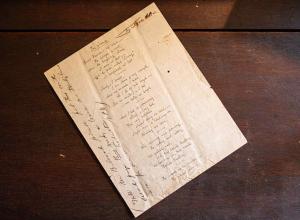December 2014 |
Requiem for the Bibliophile

"Lament" reproduced with permission from Nancy Gifford
If Jorge Luis Borges thought paradise would be a library, then he might find the gates of hell in an exhibit mourning the death of libraries and printed materials. Requiem for the Bibliophile opened in September at the Museum of Contemporary Art in Santa Barbara, where seven artists explore how the historical role of libraries is evolving to meet the needs of 21st century patrons. Each of the installations examine the power of the printed word and the emptiness that prevails when physical books are reduced to pixels.
Artist Emily Jacir's installation of photographic prints documents the 30,000 books that were looted from Palestinian homes by Israeli forces in 1948, and asks what happens when a community is denied access to their literary history. There's also an installation called "Empty Bookshelf VII" by Jorge Méndez Blake, which looks like a newly assembled project from Ikea - functional, but without books, purposeless.
By far, the standout piece is a ten foot high, thirty-two-foot-long collage called "Lament." Artist Nancy Gifford has been incorporating 'altered' books into her work for the past decade, scouring used book stores throughout the country and abroad for raw material. She gathered over 2,000 antique books for this installation - most in poor condition. "Book covers were once a form of artwork on their own, and "Lament" was an opportunity to breathe new life into a forgotten art, and to take these books off the shelf and expose them to a new audience," explained Gifford to me recently.
She then adjusted the books and covers further, ripping innards from their hardcovers, painting out spines and leaving only words Gifford felt were charged with meaning. "When I was invited to participate in this project, I wanted to explore what books represent," she said. Layering books one on top of another, they morph into a literary crypt.
"Lament" was constructed over the course of one year - a time-lapse video Gifford created (seen here) shows the painstaking work and effort this piece required. The books are affixed with screws to eight archival birch panels. Each panel is 10 feet high and 4 feet wide, with seams were designed to camouflage that the work is modular. "The center of the piece exposes the covers' insides, representing the heart of the piece, and the black exterior is the "requiem," or death shroud," Gifford explained.
Books have always been a positive part of Gifford's life. She remembers fondly the monthly bookmobile visits to her Midwestern hometown. "I cherished those humble experiences, and they planted the seed of fascination for holding a stamped leather binding. As I watch books lose their place in the world, my work with books has changed to reflect that, becoming less deferential and more destructive." In their battered, water-damaged, defaced states, Gifford's books still have valuable stories to tell.
While Gifford mourns books that have gone from repositories of knowledge to ornamentation for interior decorators, it's not all gloom and doom. The artist created a fifteen-minute film entitled "Hope," which sees our increasing desire for reading material as a positive outcome, even if we're doing more of our reading on screens.
Requiem for the Bibliophile runs through January 14, 2015 at the Museum of Contemporary Art in Santa Barbara. http://www.mcasantabarbara.org/exhibitions/requiem-bibliophile

















